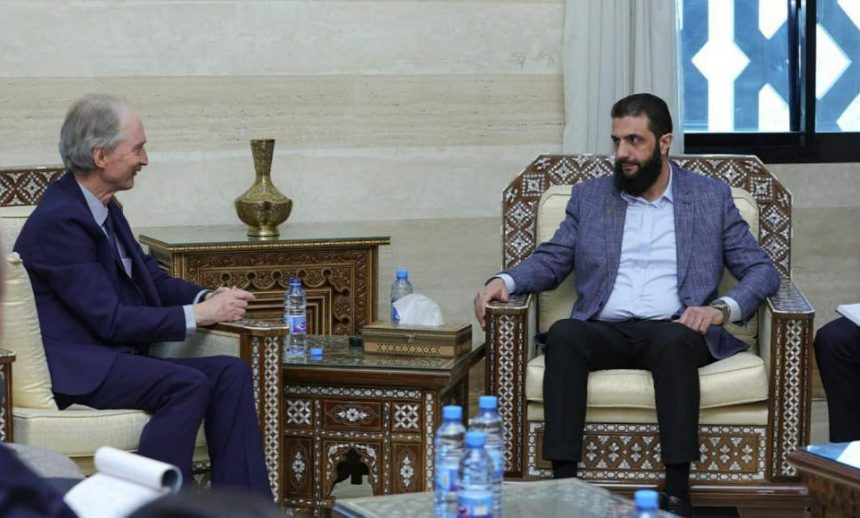During a panel discussion at the Munich Conference on Saturday, Foreign Minister Asaad al-Shibani jested with UN Envoy to Syria Geir Pedersen. Addressing the audience, he remarked: “If you want to gauge whether the situation in Syria warrants optimism or pessimism, let me tell you—this is the first time I’ve seen Mr. Pedersen smile. That’s a good sign.”
Pedersen responded, stating: “Three months into Syria’s transition, I believe my friends in Damascus are saying the right things, and their messages are highly encouraging. What I hear from Syrians across the board is their determination for this transition to succeed—they cannot afford another failure. This opportunity is a rare one and must be seized.”
It is against this backdrop of optimism that Pedersen is preparing for his visit to Syria, scheduled for this week, according to UN spokesperson Stéphane Dujarric.
This marks the first time since his appointment in 2018 (succeeding Staffan de Mistura) that Pedersen is arriving in Damascus under an air of optimism. His visit notably coincides with the launch of dialogue sessions led by the Preparatory Committee for the Syrian National Dialogue Conference.
Pedersen has previously visited Damascus, meeting with President Ahmad al-Sharaa twice—on December 12 and 20.
A Shift in Mission?
The key question surrounding Pedersen’s upcoming visit is not simply what he will bring to Damascus but whether his mission remains unchanged from before the “liberation” of December 8.
It is unlikely that his mandate will remain the same—or at the very least, adjustments should be made to reflect the trajectory of Syria’s ongoing transformation, which Pedersen himself has praised as a positive and necessary shift.
Today, there is no longer a pressing political or military crisis requiring resolution. The divide between the Syrian government and its people has ostensibly dissolved. Pedersen has explicitly stated that the transitional phase aligns with UN Resolution 2254, thereby fulfilling its criteria. This is a significant declaration, particularly given that the United Nations—and the broader international community—has consistently upheld Resolution 2254 as the cornerstone of any political settlement in Syria under the previous regime.
(To clarify, sporadic security disturbances in certain regions should not be classified as a broader military crisis; rather, they are a natural consequence of the country’s ongoing transformation. Even with regard to the Kurdish community, Syria’s new political landscape is, ultimately, open to all its citizens.)
Dujarric, in announcing Pedersen’s visit, confirmed that the envoy “will continue engagements with officials from the caretaker government and representatives of various segments of society.”
A Broader Responsibility
If Pedersen believes that Syrians cannot afford another failure and that the current transition represents a unique, one-time opportunity, then ensuring its success is not solely the responsibility of Syrians and their new leadership. In reality, facilitating this transformation is a shared obligation at both the national and international levels.
Accordingly, Pedersen’s mission must evolve. At a minimum, new provisions should be incorporated to support and reinforce this transition, ensuring its success.
A key issue in this regard is the international sanctions imposed on Syria during the era of the former regime. With the country now under new leadership, the justification for maintaining these restrictions has weakened—especially as they pose a significant obstacle to Syria’s recovery and reconstruction efforts.
Pedersen has frequently addressed this issue, advocating for the removal of sanctions. Moreover, there is a growing consensus that the so-called “concerns and fears” regarding the new leadership and the transition process are minimal—if they still exist at all.
To be precise, describing these concerns as “minimal” does not necessarily reflect the true state of affairs; rather, it underscores the political “margin” that international powers retain as a means of strategic maneuvering and leverage in ongoing negotiations. After all, politics is the art of the possible—an arena of calculated gains and seizing opportunities. This applies to all nations, but especially to global powers, which engage in such strategies on a much larger and more consequential scale.
What Comes Next?
Returning to the Munich Conference, Pedersen expanded on his response to Foreign Minister Asaad al-Shibani, stating: “There are many critical decisions that must be made in Damascus, and they must be the right ones—there is no room for error. By early March, we should see the formation of a new, inclusive government.”
Despite Pedersen’s evident optimism—his smile, his praise for the Syrian leadership’s measures, and his assertion that these steps align with Resolution 2254—the transition is not yet complete. The word “must” remains a key part of the equation.
Nonetheless, the trajectory of optimism continues to expand, bolstered by sustained and significant Arab and international engagement with Syria’s new leadership and its president, Ahmad al-Sharaa. Pedersen’s visits remain crucial, as long as Syria continues to seek cooperation and support—ensuring that such efforts are grounded in principles that serve the interests of both the state and its people.
This article was translated and edited by The Syrian Observer. The Syrian Observer has not verified the content of this story. Responsibility for the information and views set out in this article lies entirely with the author.


